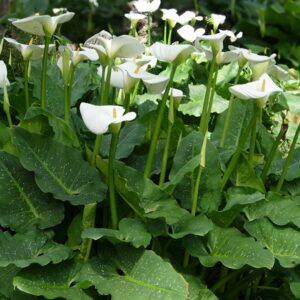Your cart is currently empty!
Unveiling the Enchanting Pink Calla Lily Bulbs: A Guide to Cultivation and Care

Introduction
Pink calla lilies, known for their trumpet-shaped blooms and elegant foliage, are exquisite additions to any garden. Their vibrant hues and long-lasting nature make them popular choices for cut flowers, bouquets, and ornamental displays.
Whether you’re a seasoned gardener or a novice enthusiast, this comprehensive guide will provide you with everything you need to know about pink calla lily bulbs, from selecting the right varieties to planting, caring for, and propagating these captivating blooms.
Selecting Pink Calla Lily Bulbs
Varieties
There are numerous varieties of pink calla lilies, each offering unique features and shades. Popular options include:
- Pink Perfection: Soft pink blooms with a delicate fragrance
- Cherry Cola: Deep pink blooms with a burgundy undertone
- Pink Diamond: Large pink blooms with a slightly ruffled edge
- Fiji: Vibrant hot pink blooms
- Estelle: Rose pink blooms with prominent veins
Size and Quality
When selecting bulbs, look for ones that are large and firm. Avoid bulbs that are soft, wrinkled, or have any signs of mold or disease. Bigger bulbs generally produce more flowers.
Planting Pink Calla Lily Bulbs
Time and Location
The best time to plant calla lily bulbs is in the spring, after the last frost date. Choose a location with well-drained soil that receives partial shade to full sun.
Planting Instructions
1. Dig a hole about twice the width of the bulb and 3-4 inches deep.
2. Place the bulb in the hole with the pointed end facing up.
3. Cover the bulb with soil and gently firm it down.
4. Water the planting area thoroughly.
Caring for Pink Calla Lilies
Watering
Calla lilies prefer moist soil but can tolerate occasional drying out. Water regularly, especially during hot, dry weather.
Fertilizing
Fertilize callas monthly with a balanced liquid fertilizer during the growing season.
Mulching
Mulch around calla lilies with organic material such as compost or shredded bark. This helps retain moisture, suppress weeds, and regulate soil temperature.
Support
As calla lily plants grow, they may need support. Use stakes or cages to prevent them from flopping over.
Propagating Pink Calla Lilies
Division
Calla lilies can be propagated by dividing the bulbs. Dig up the clumps, separate the smaller bulbs from the main bulb, and replant them in individual pots or the garden.
Seeds
Calla lilies can also be grown from seed, but this method takes longer and results in variations in bloom color and shape.
Common Problems and Solutions
Pests and Diseases
Calla lilies are relatively pest-free, but they can be susceptible to:
- Aphids: Treat with insecticidal soap or neem oil.
- Slugs and snails: Use slug bait or barriers.
- Botrytis blight: Remove infected plant parts and use a fungicide.
Nutrient Deficiencies
Yellowing leaves or stunted growth can indicate nutrient deficiencies. Fertilize regularly and test the soil to determine specific nutrient needs.
Conclusion
Growing and caring for pink calla lilies is a rewarding experience that can bring beauty and elegance to your garden. By following the tips and information provided in this guide, you can enjoy these captivating blooms season after season.
Whether you’re a seasoned gardener or just starting your horticultural journey, we encourage you to explore the world of pink calla lily bulbs. Their vibrant colors and graceful presence will transform any space into an enchanting oasis.








Leave a Reply